#Environmental issues
Explore tagged Tumblr posts
Text
youtube
Watch the 2024 American Climate Leadership Awards for High School Students now: https://youtu.be/5C-bb9PoRLc
The recording is now available on ecoAmerica's YouTube channel for viewers to be inspired by student climate leaders! Join Aishah-Nyeta Brown & Jerome Foster II and be inspired by student climate leaders as we recognize the High School Student finalists. Watch now to find out which student received the $25,000 grand prize and top recognition!
#ACLA24#ACLA24HighSchoolStudents#youtube#youtube video#climate leaders#climate solutions#climate action#climate and environment#climate#climate change#climate and health#climate blog#climate justice#climate news#weather and climate#environmental news#environment#environmental awareness#environment and health#environmental#environmental issues#environmental education#environmental justice#environmental protection#environmental health#high school students#high school#youth#youth of america#school
23K notes
·
View notes
Text
Hey, happy Earth Day! Who wants to talk about climate change?
Yeah, okay, fair, I kinda figured the answer to that would be "ugh do we have to?" What if I told you I have good news though? Good news with caveats, but still good news.
What if I told you that since the Paris Agreement in 2015, we've avoided a whole degree celsius of global warming by 2100, or maybe more?

Current projections are 2.7C, which is way better than the 3-5C (with a median of 3.7C) we were expecting in 2015. It's not where we want to be - 1.5C - but it is big, noticeable progress!
And it's not like we either hit 1.5C and avoid all the big scary consequences or fail to hit 1.5C and get all of them - every tenth of a degree of warming we avoid is going to prevent more severe problems like extreme weather, sea level rise, etc.
This means that climate change mitigation efforts are having a noticeable impact! This means a dramatically better, safer future - and if we keep pushing, we could lower the amount of global warming we end up with even further. This is huge progress, and we need to celebrate it, even though the fight isn't over.
It's working. Keep going.
#hylian rambles#climate change#climate crisis#environmental issues#global warming#hope#hope for the future#hope for the planet#earth day
22K notes
·
View notes
Text
From the article:
A hole that opens annually in the ozone layer over Earth’s southern pole was relatively small in 2024 compared to other years. Scientists with NASA and the National Oceanic and Atmospheric Administration (NOAA) project the ozone layer could fully recover by 2066. During the peak of ozone depletion season from September 7 through October 13, the 2024 area of the ozone hole ranked the seventh smallest since recovery began in 1992, when the Montreal Protocol, a landmark international agreement to phase out ozone-depleting chemicals, began to take effect.
There's a reason you don't hear about the hole in the ozone layer much anymore--it's been on the mend since the global community banned ozone-depleting chemicals in 1992. Remember that it is possible for the world to come together to solve large scale environmental problems.
#ozone hole#ozone layer#environment#environmental issues#hope#hopepunk#good news#ecoanxiety#ecogrief#ozone#environmental protection
1K notes
·
View notes
Note
can you talk about moss poaching i'm actually really curious
How can I refuse! Absolutely!!! It sounds kind of ridiculous, but it's actually very sad.
So, let's start off with some numbers. Every year, the moss black market is estimated to garner up to $165 million for trafficking approximately 82 million pounds of moss.
I cannot even wrap my mind around how much moss that is.
You might ask, why does moss poaching exist and why is it so lucrative? Well, the quality that has made mosses the prey of an illegal trade is simply their aesthetic appeal. Soft, velvety, and moist, mosses are extremely pleasant to the touch and calming to look at. Some people are willing to pay large amounts of money to collect them and put them in private gardens. However, most of the mosses that move in this underground black market are actually sold to companies/wholesalers for use in potting/gardening soil, plant nurseries, decor, and as craft materials. The majority of the preserved mosses in your run-of-the-mill chain craft store, planters, floral wreaths, or very-much-dead living wall decorations are gathered illegally, bleached to death, and then dyed green. This goes for a lot of prepackaged peat moss and soil mix blends as well.
Even though it is illegal to gather moss in public places (in the US, at least), people still harvest it. Why? Probably because there's a fair amount of money to be made and the consequences are very rarely enforced, and when they are, they are quite light--usually a $50 fine at worst if you're caught. Most of this black market moss is actually poached from the national park system, with Appalachia and the Pacific Northwest usually being the hardest hit regions.
Mosses play vital roles in many ecosystems, provide homes for threatened species, regulate water distribution in forests, and help with erosion, so their loss is a terrible blow. Additionally, moving such large quantities of mosses from one location to another may spread unwanted, invasive hitchhikers, like insects that lay their eggs in the plants, or even seeds and spores.
I'll end on this thought:
It can take 20 years for a small patch of moss removed from a fallen tree to grow back with the right moisture conditions.
How long would it take to regrow 82 million pounds?
6K notes
·
View notes
Text
"When considering the great victories of America’s conservationists, we tend to think of the sights and landscapes emblematic of the West, but there’s also a rich history of acknowledging the value of the wetlands of America’s south.
These include such vibrant ecosystems as the Everglades, the Great Dismal Swamp, the floodplains of the Congaree River, and “America’s Amazon” also known as the “Land Between the Rivers”—recently preserved forever thanks to generous donors and work by the Nature Conservancy (TNC).
With what the TNC described as an “unprecedented gift,” 8,000 acres of pristine wetlands where the Alabama and Tombigbee Rivers join, known as the Mobile Delta, were purchased for the purpose of conservation for $15 million. The owners chose to sell to TNC rather than to the timber industry which planned to log in the location.
“This is one of the most important conservation victories that we’ve ever been a part of,” said Mitch Reid, state director for The Nature Conservancy in Alabama.
The area is filled with oxbow lakes, creeks, and swamps alongside the rivers, and they’re home to so many species that it ranks as one of the most biodiverse ecosystems on Earth, such that Reid often jokes that while it has rightfully earned the moniker “America’s Amazon” the Amazon should seriously consider using the moniker “South America’s Mobile.”
“This tract represents the largest remaining block of land that we can protect in the Mobile-Tensaw Delta. First and foremost, TNC is doing this work for our fellow Alabamians who rightly pride themselves on their relationship with the outdoors,” said Reid, who told Advance Local that it can connect with other protected lands to the north, in an area called the Red Hills.
“Conservation lands in the Delta positions it as an anchor in a corridor of protected lands stretching from the Gulf of Mexico to the Appalachian Mountains and has long been a priority in TNC’s ongoing efforts to establish resilient and connected landscapes across the region.”
At the moment, no management plan has been sketched out, but TNC believes it must allow the public to use it for recreation as much as possible.
The money for the purchase was provided by a government grant and a generous, anonymous donor, along with $5.2 million from the Holdfast Collective—the conservation funding body of Patagonia outfitters."
youtube
Video via Mobile Bay National Estuary Program, August 7, 2020
Article via Good News Network, February 14, 2024
#united states#alabama#estuary#wetlands#swamp#river#environment#environmental issues#conservation#video#biodiversity#american south#ecosystems#ecology#conservation news#wildlife conservation#ecosystem#conservation efforts#good news#hope#forest#swampco#re#Youtube
2K notes
·
View notes
Text
I have some Concerns™ about Canada's air quality and I'm not seeing much reported on it here in the states.

Canadians, you all okay up there??
#humanitarian issues#I mean clearly not#but the news is only reporting about the fire itself and not about its impact#other than evacuations#environmental issues#and by news I mean US news
525 notes
·
View notes
Link
#d20 fanzine#cotl narinder#slime feet#jornada interior#missing#environmental issues#ttrpg#Krix#yogapractice#anakin skywalker#Fetiche#comic
249 notes
·
View notes
Text
youtube
Watch the American Climate Leadership Awards 2024 now: https://youtu.be/bWiW4Rp8vF0?feature=shared
The American Climate Leadership Awards 2024 broadcast recording is now available on ecoAmerica's YouTube channel for viewers to be inspired by active climate leaders. Watch to find out which finalist received the $50,000 grand prize! Hosted by Vanessa Hauc and featuring Bill McKibben and Katharine Hayhoe!
#ACLA24#ACLA24Leaders#youtube#youtube video#climate leaders#climate solutions#climate action#climate and environment#climate#climate change#climate and health#climate blog#climate justice#climate news#weather and climate#environmental news#environment#environmental awareness#environment and health#environmental#environmental issues#environmental justice#environment protection#environmental health#Youtube
23K notes
·
View notes
Text
I write this as I sit in the nature near my home. When I was young my friends and I played here, climbing over the rocks, occasionally falling into the water (heavily polluted). In recent times I have become acquainted with this place.
I see the families with their small children come by to feed the ducks, I know the kinds of rubbish that collects here, what rocks disappear beneath the water when it rains, when the birds get loud in the trees, the cracks in the rocks the lizards run off too, the parts of the creek the different water birds prefer.
I encourage thee, come to know the creatures you share a home with, the plants they eat, when they breed, when do they come out, when do they sleep? Take your friends, take your children. Watch as the land changes, teach them these things.
What plagues the nature near you? Pollution, habitat distraction, invasive species. Get in touch with local councils, read their reports, join local groups, cleaning up rubbish and invasive weeds. If you live in a city, come to know what plagues it. Start with your home. I think of there is one thing people know it is how to build a home.
There is no greater blessing than understanding the creatures. As long as you live in this place, the same place as they do, you are their kin. If you do not care for one another then nobody else will.
We are not politicians, we are not the CEO’s of companies. We are simply animals in our home, that we must protect with all our might.
#otherkin#nonhuman#therian#therianthropy#nature#alterhuman#wolfkin#wolf therian#nonhumanity#humans#human beings#hope for the future#hope#hopecore#hope for humanity#hope in humanity#nonhuman community#environment#pollution#environmental issues#environmental#sustainability#conservation#land conservation#sustainable living#sustainable lifestyle#nature witch#forest witch#green witch#witchcraft
179 notes
·
View notes
Text

Catherine, Princess of Wales attends The Earthshot Prize 2022 at MGM Music Hall at Fenway on December 02, 2022 in Boston, Massachusetts.
#catherine princess of wales#princess kate#earthshot prize#boston massachusetts#kate middleton#green dress#british royalty#environmental issues#off the shoulder#british royal family#british royal fandom#emerald#royal style
116 notes
·
View notes
Text
"Winning what’s been called the ‘Green Nobel’ an Indian environmental activist has been recognized for saving a 657 square-mile forest from 21 coal mines.
From the New Delhi train station to high-end hotels to the poorest communities, virtually no one in India is free from periodic blackouts. As part of the Modi regime’s push for a developed and economically dominant India, power generation of every sort is being installed in huge quantities.
GNN has reported this drive has included some of the world’s largest solar energy projects, but it also involves coal. India is one of the largest consumers of coal for electricity generation, and Hasdeo Aranya forests, known as the “Lungs of Chhattisgarh,” are known to harbor large deposits.
The state government had been investigating 21 proposed coal mining blocks across 445,000 acres of biodiverse forests that provide crucial natural resources to the area’s 15,000 indigenous Adivasi people.
Along with the Adivasi, tigers, elephants, sloth bears, leopards, and wolves, along with dozens of endemic bird and reptile species call this forest home. It’s one of India’s largest intact arboreal habitats, but 5.6 billion metric tons of mineable coal threatened to destroy it all.
Enter Alok Shukla, founder of the Save Hasdeo Aranya Resistance Committee, which began a decade ago advocating for the protection of Hasdeo through a variety of media and protest campaigns, including sit-ins, tree-hugging campaigns, advocating for couples to write #savehasdeo on their wedding invitations, and publishing a variety of other social media content.
Shukla also took his message directly to the legislature, reminding them through news media coverage of their obligations to India’s constitution which enshrines protection for tribal people and the environments they require to continue their traditional livelihoods.
Beginning with a proposal to create a single protected area called Lemru elephant reserve within Hasdeo that would protect elephant migration corridors and cancel three of the 21 mining proposals, Shukla and the Adivasi began a 160-mile protest march down a national highway towards the Chhattisgarh state capital of Raipur.
They hadn’t even crossed the halfway mark when news reached them that not only was the elephant reserve idea unanimously agreed upon, but every existing coal mining proposal had been rejected by the state legislature, and all existing licenses would be canceled.
“We had no expectations, but the legislative assembly voted unanimously that all of the coal mines of Hasdeo should be canceled, and the forest should be saved,” Shukla says in recollection to the Goldman Prize media channel.
“That was a very important moment and happy moment for all of us.”
Shukla shares the 2024 Goldman Environmental Prize with 5 other winners, from Brazil, the US, South Africa, Australia, and Spain."
youtube
-via Good News Network, May 20, 2024. Video via Goldman Environmental Prize, April 29, 2024.
#forests#india#conservation#deforestation#conservation news#goldman prize#biodiversity#coal mining#coal#climate action#climate hope#fossil fuels#environmental issues#indigenous#human rights#adivasi#nature reserve#hasdeo#good news#hope#hope posting#Youtube
292 notes
·
View notes
Text
‼️‼️URANIUM IS BEING ILLEGALLY TRANSPORTED ACROSS NATIVE LAND‼️‼️
#native american#American#america#us politics#police#politics#environment#climate change#nuclear war#nuclear weapons#usa#usa news#united states#american politics#environmentalism#environmental issues#world news#news#american news#north America#human rights#protests#navajo#navajo nation#uranium#go green#climate crisis#climate action#climate justice#climate solutions
79 notes
·
View notes
Text
Nausicaä of the Valley of the Wind: Why This is My Favourite Ghibli Movie
CW: Major high-school English teacher vibes ahead. Proceed at your own risk.
Nausicaä of the valley of wind is a story of the titular character Nausicaä and her being a bridge between the world of humans and nature to bring peace, thus fulfilling an ancient prophecy.
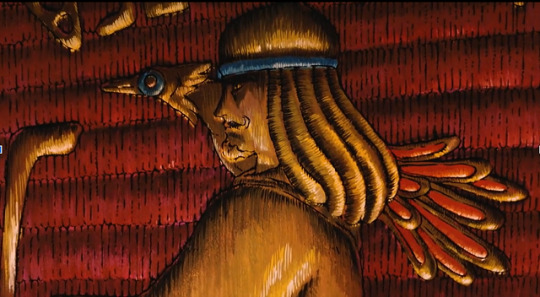
Nausicaa is the princess of the Valley of the Wind. The film begins with her walking and exploring the Sea of Decay, an area with toxic air, plants and fungal spores. She collects some spores and finds the hard molten shell of an Ohmu (gigantic blue-blooded trilobite-looking creatures), which her people use to make weapons and tools. As the name suggests, the Valley of the Wind is a civilisation that depends on and bases their culture around wind, which one can see through an abundance of windmills and gliders, including the one that Nausicaä rides. They are shown to be peaceful people who do not interfere with the politics of the warring human kingdoms or disturb nature. Nausicaä in particular is shown to have a special gift with animals—from calming Ohmus to having a pet fox-squirrel. As the existence of the kingdom depends on the sea wind that shields them from the effects of the sea of decay, there is a general reverence towards nature and its other members such as the Ohmus, that are often referred to with honorifics.
This was an element I liked: the symbolism goes deep in this film; for example, with the nature of wind—it being the very breath necessary for life is contrasted with its other face, through toxic spores in the sea of decay capable of killing anyone who inhales it.
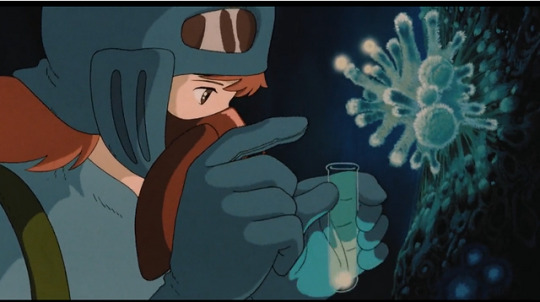
It is revealed that humans had built The Giant Men, weapons so dangerous—not unlike our atomic bombs as shown through the characteristic mushroom cloud—that the destruction caused by the war had unleashed the fury of the Ohmus, an otherwise gentle species. They wiped out entire civilisations and where they died, the Sea of Decay grew on their decomposing corpses, showing how all life is interconnected and that even in death the rage of the Ohmus, and through them the rage of nature, wouldn't subside. It is then that the viewers find out that this is not some far-off planet, but a post-apocalyptic future on earth.
New species of plants and fungi made the Sea of Decay their habitat—nature and life always find a way. It is implied that the humans lost the war referred to as the Seven days of Fire, but the truth is that it is not a war that can ever be won. Even if you win the war against nature you lose. As the story progresses, we see that the plants and fungi that Nausicaä collected from the Sea of Decay are actually trying to purify the soil and water—nature holds no grudges but only seeks balance.

The seventh of the Giant Men, a sentient atomic bomb if you will, apparently hid underground for a thousand years until the kingdom of Pejite found it for use against their enemy, the Tolmekians. They both remain oblivious to the sheer destruction that can be caused by this Giant Man and they don't care either. Despite the balance between humans and nature being a delicate one, instead of trying to rebuild together, they justify to themselves that the war is necessary for self-preservation and to put humans back on top of the food chain.
In their hubris, the Tolmekians and their princess Kushana believe that with the help of their superweapon they can destroy the Sea of Decay despite knowing that it will trigger the wrath of the Ohmus. The Giant Man however is not complete and hence, though the devastation is great, the final giant man dies and all that remains to be done is to calm the wrath of the Ohmus.
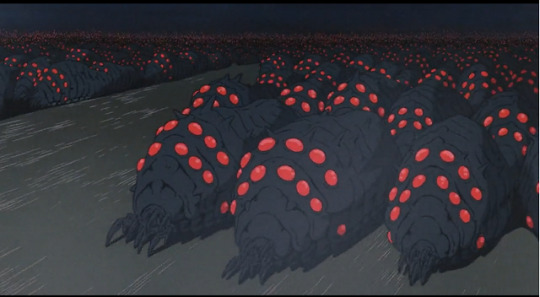
Nausicaä saves an Ohmu child who was injured by Tolmekian soldiers to lure the Ohmus into a war. She saves the baby Ohmu and sacrifices her own life to calm the sea of maddened Ohmus. The now-calm Ohmu then revive Nausicaä, symbolising the mystical healing power of nature and its ability to support and create life.
Nausicaä is an excellent protagonist, and how the trope of the chosen one is utilised is beautiful and full of symbolism. Right from the get-go, we see her being inquisitive and brave. She is willing to defend her people but not through violence. And it is made abundantly clear that her avoidance of violence is not due to any lack of strength; when she strikes down the soldiers who killed her father, rather than feeling any sense of pride (as one might expect from a character not used to strength), it sickens her. She shows understanding even towards Kushana, whose men took over her kingdom. She sincerely loves and respects animals and plants.
There was a prophecy among the people of the valley of wind that a person clad in blue over golden fields will save their kingdom and bring peace. And towards the end of the film, Nausicaä's clothes becoming blue with the blood of the baby Ohmu she saved and the golden fields being the tendrils of the Ohmus healing her is poetic to say the least.
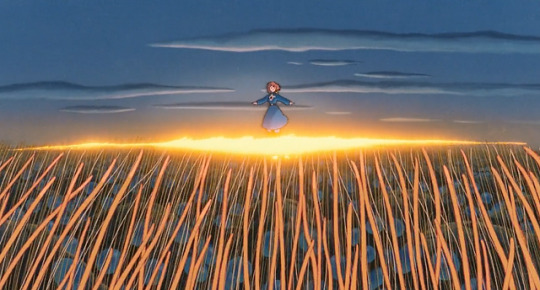
In addition to a good female protagonist, we also get a powerful female antagonist in Kushana, who starts out as a one-note expansionist ruler, but it is revealed that she lost her limbs and got severely maimed by the sea of decay, motivating her to destroy it once and for all. Proud and arrogant, sure, but she has a motive beyond just wanting power and possesses some form of a moral code. In another story she could be the protagonist bravely defending humanity against the evil, alien-esque trilobites and spores.
It was a unique and meaningful choice on Miyazaki's part to symbolise nature through the Ohmus—alien-looking giant insects—instead of something cute and fluffy. Oftentimes humans care more about the conservation of animals that they find cute (pandas over, say, Panamanian golden frogs), but an animal doesn't have to appeal to human aesthetics to be worth conserving.
Absolutely not to be missed is the breathtaking soundtrack by Hisaishi. There are symphonies, techno music, sitar-like instruments and a child's humming, all elevating every scene to give a moving experience.
Ultimately it is an ambitious story that aims to deal with themes of coexisting with nature, the futility and dangers of war, and of how innocent children who should live carefree lives are dragged into it and made heroes. This film is often categorised as falling into the genre of Solarpunk: a literary and artistic movement that centres around building a sustainable future interconnected with nature and community. Although this film does depict violence and wars, it ultimately shows a peaceful future is possible.
Truly a masterpiece. 9/10.
#analysis#culture#short essays#media#anime#fictional characters#film#ghiblicore#studio ghibli#musings#movies#solarpunk#climate change#nuclear#environmental issues#environment#miyazaki#feminism#review#character analysis#nausicaa#animanga#animals
234 notes
·
View notes
Text
Environmental defender Rowena Dasig has gone missing after a court dismissed the trumped-up charges against her.
Dasig, who was reportedly freed from the Lucena City District Jail (LCDJ) on August 22, has not been seen or heard from since her supposed release, leaving her family, legal team, and human rights advocates concerned for her safety.
Dasig was arrested alongside community health worker Miguela Peniero on July 12, 2023, by elements of the 85th Infantry Battalion, Philippine Army (IBPA).
The human rights group [Karapatan Southern Tagalog] recounted how their humanitarian team, along with the Free Owen & Ella Network, had been coordinating with LCDJ since August 21 to process Dasig’s release papers. Despite their efforts, they were met with what they called as “delaying tactics” from jail officials. The group said they were given the runaround by various offices without providing clear information.
According to LCDJ paralegal Almira Alfuerta, Dasig was allegedly picked up by her family—a claim immediately refuted by her relatives, who confirmed they had no knowledge of her whereabouts.
The disappearance of Dasig has heightened fears for her safety, especially given the long history of human rights abuses against political prisoners in the Philippines.
During her more than a year in detention, Dasig endured harassment and isolation, with her paralegals deprived from visiting and herself denied participation in activities with other persons deprived of liberty (PDLs).
2024 Aug. 24
#junk anti terror law#surface all desaparecidos#philippines#persons deprived of liberty#state violence#environmental issues#afp-pnp
37 notes
·
View notes
Text
Source: Tripybara on Threads
Israel's genocidal violence isn't just killing Palestinians.
It is killing the entire ecosystem of the Levant
Israel must be stopped.
Nothing. Literally nothing justifies this.
(Also this is further proof that Israel is nothing but a european settler colony. Because no Indigenous people would ever do this to their land. Ever.)
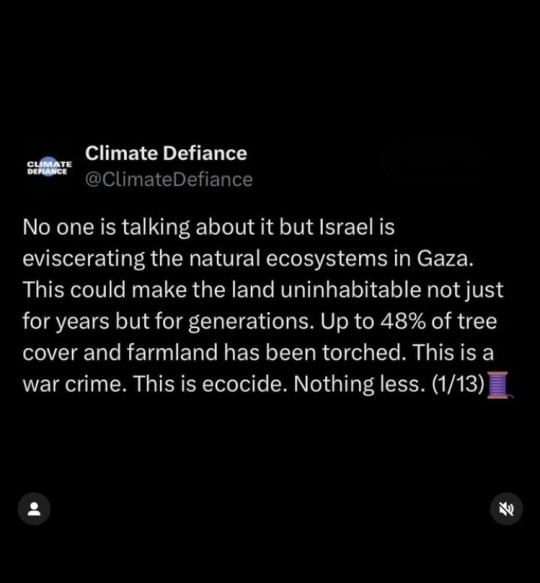

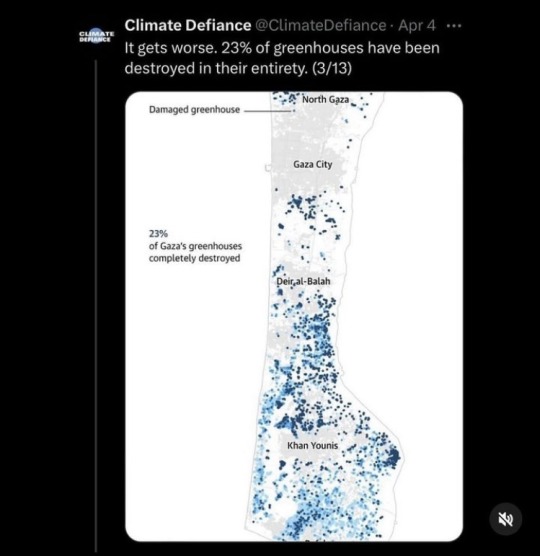
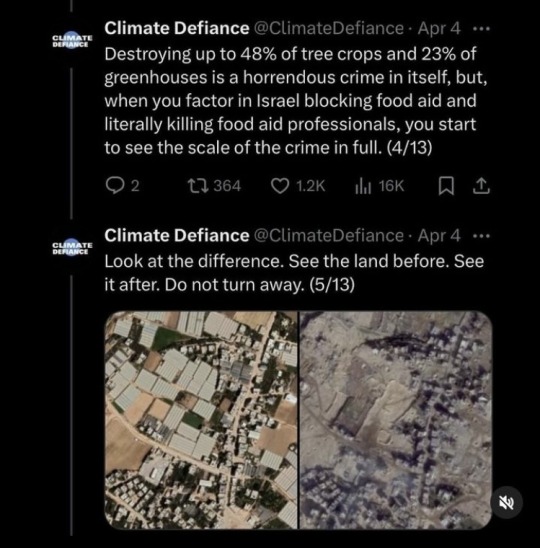
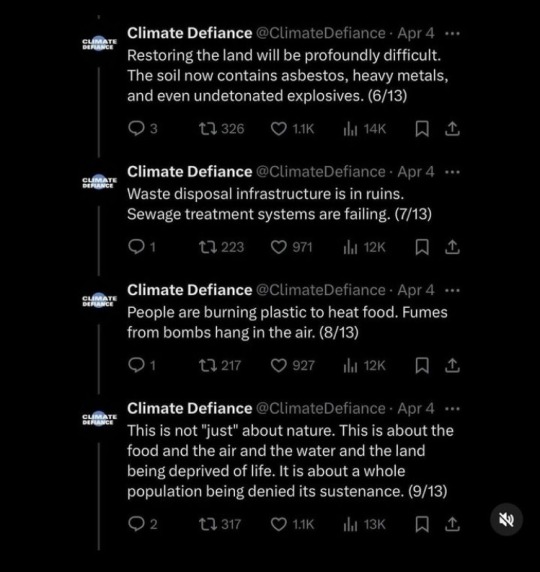
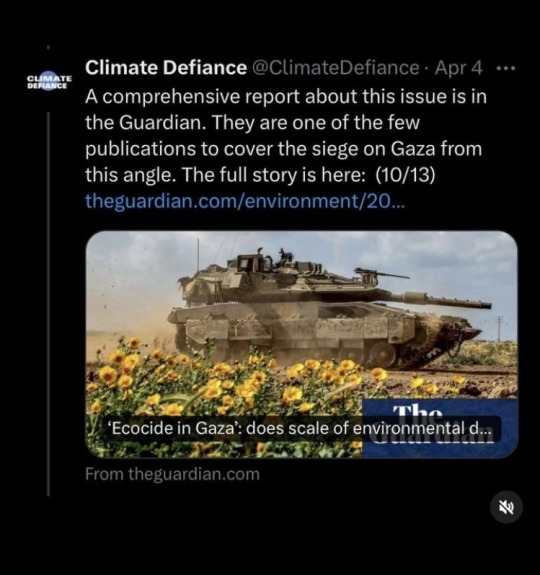
#threads#threads app#social justice#current events#human rights#yemen#tel aviv#jerusalem#free palestine#gaza#free gaza#palestine#gaza strip#gaza genocide#save gaza#gazaunderattack#freepalastine🇵🇸#free palastine#from the river to the sea palestine will be free#palestine 🇵🇸#ecology#environmentalism#environmental science#environmental awareness#environmental issues#environmental impact#news on gaza#palestine news#stand with gaza#gazaunderfire
82 notes
·
View notes
Note
Considering your moss poaching post, do you have any advice on how to source ethical moss? Especially large quantities like for a moss garden? I've always wanted one instead of a lawn but I don't want to wreck an ecosystem for it.
I do!! Also, sorry for the delay on this, I'm moving abroad and the preparations have made the past couple of weeks kind of crazy and I wanted to make sure to give a proper (and hopefully helpful!) answer. It is absolutely possible to get yourself some ethically-sourced live moss (even in larger quantities)! Places that cultivate moss are usually smaller-scale since the process can be a bit tricky, so it might take a bit of coordination for a larger amount.
In terms of live moss, there are dedicated moss nurseries that grow, harvest, and then sell different varieties. Their method is similar to that of mushroom farms, involving logs placed in a damp area in or near wooded land. Moss Acres cultivates their moss this way in a nursery that spans many acres. They also work with a sister company that makes living, ethically-cultivated and harvested moss walls.
Another really great option is Mountain Moss. They mainly rescue moss from land that is slated for development, saving it from being thrown out to make way for buildings. They are also certified to collect native mosses that would otherwise be destroyed and have all the proper permits to distribute them (both things to check on when picking a moss supplier). A lot of their moss ends up going to native restoration projects, which is amazing as well. They do a lot of public outreach too through lectures and workshops on moss gardening, moss terrariums, etc.
Also check with local plant nurseries near you, as lots of them cultivate moss (there's one near me that has a dedicated moss patch).
Main things to keep in mind when choosing a moss supplier:
· Do they cultivate the moss themselves in a nursery?
· If not, is it sourced from private land where it would otherwise be destroyed? Do they have a harvesting permit and an agreement with the landowner?
· Is the moss native to where you want to plant it?
· How do they harvest the moss? (even nursery moss needs to be gathered in smaller quantities from various parts of the nursery to fulfill a larger order)
· Is the type of moss endangered?
· Are they certified to distribute live moss?
Just as a side-note, for anyone who gardens with peat/sphagnum moss, a good sustainable alternative is coco coir! Also, if that doesn't suit your needs and you definitely need a moss-based growing mix, Sun Gro harvests ethically and sustainably, as does Better-Gro.
Hope this helps a bit, happy mossing! If anyone sees this and has other suggestions on where to look for ethical moss, please feel free to add on :)
#ask#asks for me!!!#moss#ethical moss#mosscore#nature#moss poaching#environmental issues#sustainable#sustainability
173 notes
·
View notes